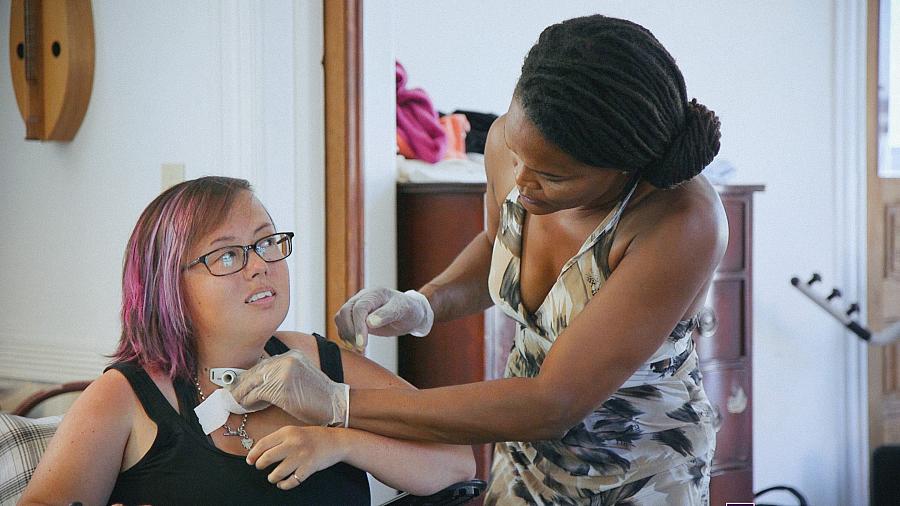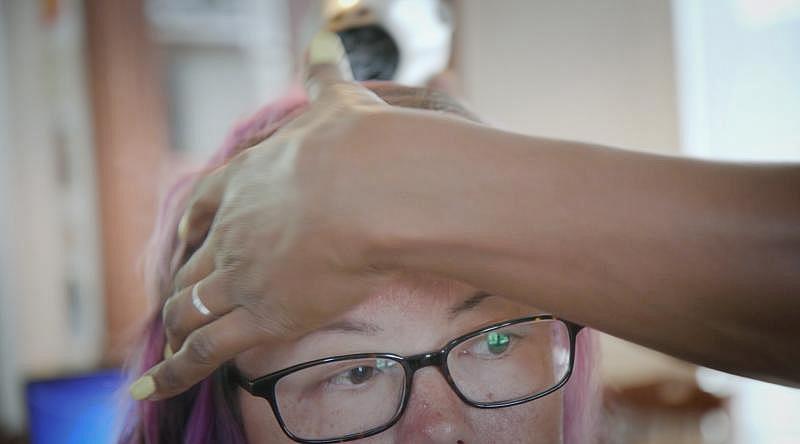Framing health care as a civil right

Stacey Milbern of Oakland, California relies on Medicaid-funded attendants to get out of bed, eat, bathe, and get around. (Jeremy Raff / The Atlantic)
The Republican party’s seven year quest to repeal the Affordable Care Act is dead for now. Beneath the fevered political rhetoric, a big factor in the repeal bill’s demise was that one-in-five Americans now rely on Medicaid, and key lawmakers feared that there is no way to cut billions from the safety net without harming millions of people.
More than 80% of the safety net funds children, elderly, and disabled people, putting them at particularly high risk under the 35% budget cut in the failed Republican proposal. Though wholesale repeal is off the table for now, many disabled Americans say the fight for their health care -- and the other fundamental rights it guarantees by extension -- is never really over.
That’s why my California Fellowship story was an opportunity to take look at health care through a civil rights lens, as many disabled people who rely on Medicaid see it.
This story began like so many others in documentary video -- with a search for the place, person, or relationship that could make the big, messy issue of ACA repeal concrete and visible. As I began talking to advocates and analysts, the issue of in-home health care came up again and again. A big cut in Medicaid would force states to make hard choices, and a likely target would be any service considered optional by law. In-home health aides that assist elderly and disabled people with everyday living -- getting out of bed, bathing, eating, leaving the house -- are both costly and optional for states to fund. In phone calls, I heard a dozen versions of this description from Stacey Milbern, a human resources professional who relies on in-home care: “It's life or death.”
But though Milbern feared losing her workers, she was not yet ready to let me film these intimate moments. So for the time being, I turned my attention to the little-known but newly relevant civil rights backstory of how disabled people originally got access to in-home care.
**
Huge black and white photos line the airy lobby of the Ed Roberts building in Berkeley, California. They depict a seminal protest of the disability rights movement, where Roberts articulated a powerful idea: the problem for disabled people trying to access housing, education, and jobs is a society that prevents them from doing so, not disability itself.
A sweeping red-painted circular ramp loops up to the second floor of the Roberts building, which houses several prominent disability rights organizations. The ramp is a stylish way to access upper level offices, and emblematic of hard-won battles for a built environment that works for disabled people, according to Mary Lou Breslin, who works on the second floor at Disability Rights Education and Defense Fund. Today, the Bay Area is so accessible to people with disabilities that it attracts transplants from all over the country. Breslin appears in one of the black-and-white photos in the lobby, singing protest songs as a college-aged participant. When we spoke, debate over the Republican proposal raged in Congress. Breslin worried that the unprecedented Medicaid cuts in the ACA repeal bill would “set us back 30 years.”
Though the 1977 protest at San Francisco City Hall laid the legal foundation for the Americans with Disabilities Act, Breslin explained, its most lasting impact was to link the struggle of people with disabilities to the wider civil rights movement. In a memorable confrontation recorded by a news crew, protest organizer Judy Huemann scolds a federal official sent to mollify the protesters. “Stop shaking your head in agreement,” she said. “We want no more segregation.”
I met up with Huemann at her swanky apartment on leafy Connecticut Avenue in Washington, D.C. After the San Francisco protest she became a leading international voice for disability rights, and served in the Clinton administration and in Obama’s State Department as a special advisor on disability rights. She said the Section 504 sit-in, as it's known, “was the first time we had come together and felt our power.”

It was in this spirit of demanding rights through the act of showing up and being visible that Milbern, the human resources manager who expressed reticence about participating, agreed to appear on camera in the vulnerable moments when she’s getting ready for the day with assistance from Medicaid-funded workers. Participating in the video, she said in June, was “a pride month present to myself.”
When we published the story, comments flooded into The Atlantic’s social media feeds. “I'm going to go pass out now, omg,” Milbern wrote on Facebook, adding “please watch it, share, and call your senators ... we are talking about life and death issues, right here, right now.” At least one senator took notice. Sen. Kamala Harris (D-CA) shared the story on social media with this quote from Milbern: “It's not just about health care, it’s really about my ability to participate in society.” The ACLU contacted Milbern to write an editorial.
But the most resounding reaction seemed to be from other people with disabilities, avid news consumers who don’t often see their experience at the center of national coverage. One commenter castigated media stories about the protests outside of Senate Majority Leader Mitch McConnell’s office, saying they “refuse to go the one extra step needed to figure out why people feel strongly enough about this to be dragged away and arrested,” but that “this story doesn't make me so angry.” Another wrote, “Can I be real for a moment? Were it not for Medicaid-funded programs, I never would have been able to leave home at 18 to attend college,” saying the threat to Medicaid was “inducing so much fear and panic and trauma in the disability community.”
In an era where questions of law, politics, and basic human decency that once seemed settled are now newly up for grabs, this story affirmed my commitment to use documentary to draw fresh attention to civil rights struggles through a first-person point of view.

